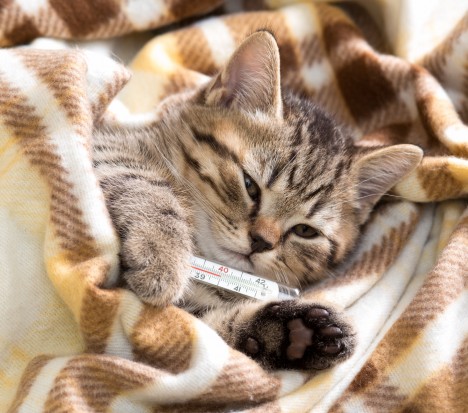

Feline calicivirus (or FCV for short) is a viral condition that leads to flu-like symptoms in the cat, and can present with varying degrees of severity. There are several different strains of the virus itself, and like many other viral conditions, the virus has the ability to mutate and change over time, meaning that cats do not develop full immunity to the condition after recovery from a first attack. However, cats that have recovered from the condition once, or that have been vaccinated against the condition will likely only suffer from a milder case of the illness if they should be unlucky enough to contract it a second time.
Feline calicivirus is highly contagious, and can soon spread between cats living in the same household, or via contact with other cats when out and about or staying in a cattery. Read on to learn more about feline calicivirus, or FCV.
As a viral condition, calicivirus can enter the body of the cat through the eyes, mouth and nose after contact with the virus itself. The virus is carried on infected cats, and also potentially on equipment such as bowls and bedding that have come into contact with an infected cat. Calicivirus can live outside of a host body for up to seven days after contact, and so the virus can easily be spread by equipment and even people who have had contact with an affected cat.
Because calicivirus comes in various different strains and has the ability to mutate, symptoms may differ from cat to cat and in case to case.
The most common symptoms of calicivirus may include any or all of the following:
Your vet may be able to diagnose calicivirus simply by taking a note of your cat’s medical history and current symptoms, and testing may not always be necessary in order to treat the condition.
However, cats that have been in contact with a lot of other cats, such as in a cattery, may require testing to reach a definitive diagnosis, due to the implications for the other cats that they have come into contact with.
Diagnosis can be made by taking a throat swab, which will then be analysed in a laboratory. However, cats can also be carriers of the virus without showing signs of sickness themselves, so it is possible that this test can return a false positive result. Also, if the virus is present within the body but only in very low numbers, it is possible to return a false negative result on the test too.
There is not currently a specific antiviral treatment available for feline calicivirus, and so treatment of the condition usually involves dealing with the symptoms and keeping the cat comfortable and as well as possible while their body fights off the virus naturally.
Decongestants may be used to ease breathing, antibiotics may be administered to prevent the possibility of secondary bacterial infections, and sometimes, IV fluid therapy may be used too if the cat is dehydrated.
Cats that are infected with calicivirus will shed the virus from their nasal, oral and ophthalmic secretions, for at least one month after infection. After this time, most cats will become clear of the virus, but some cats may become carriers of the condition, where they are no longer affected by the condition themselves, but continue to secrete the virus and run the risk of infecting other cats.
However, the viral load that any cat sheds will decrease with time, so the longer it has been since infection, the less likely it is that the cat will still be carrying the virus.
While there is no sure-fire way to prevent your cat developing calicivirus, there are some steps that you can take to lower their risks of infection.
Copyright © 2005-2016 Pet Information All Rights Reserved
Contact us: www162date@outlook.com